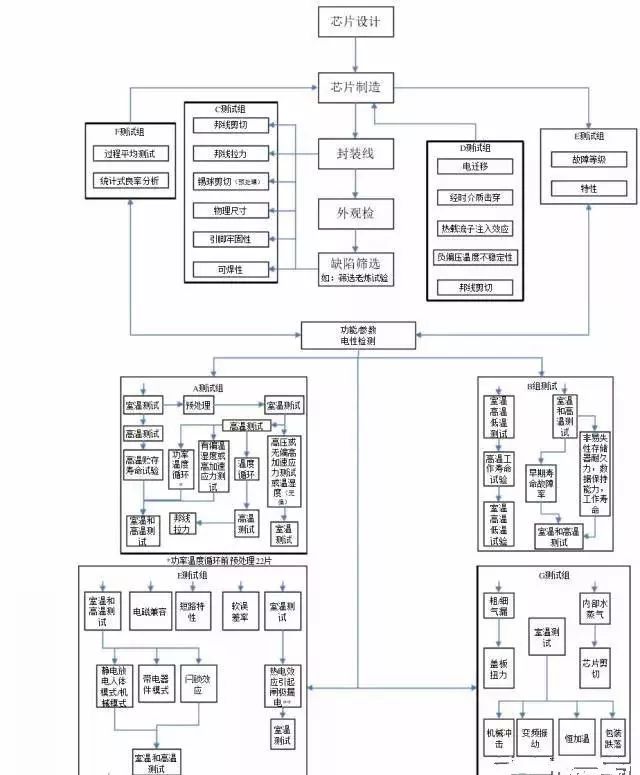
Source: One Overview of Automotive
The prices of automotive electronic products are generally quite high, one of the main reasons being the use of automotive-grade electronic components. But what kind of electronic components qualify as automotive-grade? Let’s first take a look at the differences between the application of electronic components in automobiles and those in general consumer electronics.

Environmental Requirements
Temperature: Automotive electronics have a relatively wide working temperature requirement for components, which varies according to installation locations, but generally exceeds the requirements for civilian products (it is said that AEC Q100 removed the 0℃-70℃ temperature requirement in the H version, as no automotive product requires such a low specification).
Examples:
-
Engine vicinity: -40℃-150℃;
-
Passenger compartment: -40℃-85℃;
-
Civilian products: 0℃-70℃.
Other environmental requirements such as humidity, mold, dust, water, EMC, and erosion by harmful gases are often higher than those for consumer electronics.

Vibration and Shock
Automobiles operate in environments where they encounter much more vibration and shock compared to many other products. This requirement is often significantly higher than that for products used at home.

Reliability
To illustrate the automotive requirements for reliability, I will explain it in another way:
1. Design Life: Generally, the design life of an automobile is around 15 years or 200,000 kilometers, which is far greater than the requirements for consumer electronics.
2. Under the same reliability requirements, the more components and links that make up the system, the higher the reliability requirements for the components. Currently, the level of electronic integration in vehicles is very high, with a large number of electronic devices installed from the powertrain to the braking system, each device consisting of many electronic components. If we simply consider them in a series relationship, then to ensure that the whole vehicle achieves a certain level of reliability, the requirements for each part of the system are very high. This is why the requirements for automotive parts are often described using PPM (parts per million).

Consistency Requirements
Today’s automobiles have entered a stage of mass production, with tens of thousands of units being produced in a year, which places very high demands on product quality consistency. This was quite challenging for semiconductor materials in earlier years.
After all, it is quite difficult to control the consistency of processes such as diffusion in semiconductor manufacturing, leading to performance variability in the products produced. In the past, aging and screening were relied upon to ensure quality, but with continuous improvements in processes, consistency has greatly improved. Quality consistency is also the biggest difference between many local suppliers and internationally renowned suppliers. For complex automotive products, poor consistency of components leading to safety hazards in the entire vehicle is certainly unacceptable.
Now, let’s look at some other requirements:

Manufacturing Processes
The requirements for manufacturing processes in automotive products, although automotive parts are continuously evolving towards miniaturization and lightweight design, still allow for some relaxation in volume and power consumption compared to consumer products. Generally, larger packaging is used to ensure sufficient mechanical strength and compliance with the manufacturing processes of major automotive suppliers.

Product Lifecycle
Although in recent years, the prices of automotive products have been continuously decreasing, automobiles are still durable goods that must maintain a considerable supply capability for after-sales parts over a long period. Additionally, developing an automotive component requires a significant amount of validation work, and the validation work brought about by replacing components is also substantial. Therefore, both vehicle manufacturers and component suppliers need to maintain a stable supply for a long time.

Standards
It can be seen that meeting automotive product requirements is indeed complex, and the above requirements are for automotive parts (for electronic components, it refers to the system). How to convert these into requirements for electronic components becomes quite challenging. To address this issue, certain standards and specifications have emerged, with the AEC standards being widely recognized:
-
AEC Q100 for Active Device requirements
-
AEC Q200 for Passive Device requirements
Of course, I suspect many people will also mention the various vehicle manufacturers’ corporate standards. However, I would like to share my understanding on this. In the vehicle manufacturers I have previously worked for, there were indeed related general reliability requirements standards, but they assessed a complete automotive component (a system composed of electronic components), rather than directly targeting the requirements for the electronic components that make up these components (resistors, capacitors, transistors, chips, etc.). Although their requirements can be used as a reference for selecting lower-level components, they are still not very suitable for electronic component testing.

Verification of Automotive Standards
In my previous work, it was inevitable to use some electronic components that did not have AEC Q100/200 certification. Many automotive personnel would hope to conduct some reliability verification to confirm whether they meet automotive standards.
My personal view is that this method is not very effective, as these tests can only be necessary but not sufficient. They can only be used to negate the usability of the device but cannot confirm its usability.
The reason is simple: the sample size is too small, and the test items are insufficient. For semiconductor components, which are manufactured in large quantities, determining their reliability through a small number of sample tests is, in my opinion, very unreliable. Here we can also take a look at the main certification test items conducted by AEC Q100 to see the differences.


Which Standard Has Higher Requirements?
Who has higher requirements, automotive or industrial? It is generally believed that the order of standards from high to low is Military > Automotive > Industrial > Consumer Electronics. However, I cannot completely accept this order. Industry is a very broad field, and the environmental and reliability requirements encountered can also vary greatly. One can imagine that the reliability requirements for a large industrial device are certainly not lower than those for automobiles (for example, critical equipment in a large power plant), and the harshness of the environment may also far exceed the requirements of automobiles. Therefore, it cannot be simply stated that industrial requirements are lower than automotive.

Disadvantages of Using Automotive-Grade Components
No choice can come without drawbacks. What are the disadvantages of using automotive-grade electronic components?
First of all, they are expensive; the system requirements are high, development and verification costs are significant, and low production volume leads to costs that are much higher than consumer electronics. The relatively high barriers also create a considerable sales premium.
Secondly, the selection process is difficult. Those involved in electronics know that, as of today, electronic components are quite abundant, and there can be various solutions for products with the same functionality, with potentially huge differences in complexity. However, sometimes to meet automotive standards, one has to abandon some highly integrated solutions.
Another obvious drawback is that some products are technologically outdated, and the extensive verification work affects the speed of new product launches. Furthermore, chip manufacturers generally prefer to apply products to the automotive market only after they have matured in the consumer electronics market. For example, in 2013, I developed a product that used the ARM Cortex A9 processor, which was already considered one of the best products in the automotive market at that time, while the ARM Cortex A57 processor was not uncommon in the consumer market.

What Are the Risks of Using Non-Automotive-Grade Electronic Components in Vehicles?
This question is quite complex and must be evaluated from multiple aspects:
1. If a product lacks relevant certification but actually meets performance and reliability requirements and has been validated through extensive applications, the risk is relatively low.
2. A very important point is the relationship between components and systems. The performance and reliability of the system are constituted by the lower-level electronic components, so under the same design, using non-automotive-grade components will certainly lead to inferior products. However, a good design can lower the performance requirements of the components. A well-designed protective measure that minimizes the impact of component failure on the system can potentially allow for better products using non-automotive-grade components.
Due to current technological constraints, not every electronic component required for automotive applications can meet so-called automotive-grade requirements. However, to achieve certain functions in vehicles, these components must be used. This situation can be divided into two categories:
a. High safety requirements for the function, cannot accept deviations
Example: The emergency call (E-CALL) function requires a backup battery to ensure functionality. This function relates to life safety, and according to certain company’s ASILI (ISO26262) ratings, it must meet Class B standards.
We know that it is quite challenging for batteries to maintain high performance at -40 degrees. Therefore, some companies’ solutions involve wrapping heating resistance wires around the battery to heat it at low temperatures to ensure performance. While this approach may not meet the standards of individual components, it can satisfy the standards of the vehicle manufacturer when considered as an assembly. This also illustrates the relationship between vehicle manufacturers’ corporate standards and component standards.
b. The function generally does not involve safety, deviations can be accepted
For example, the LCD screen of an entertainment system may experience reduced responsiveness and optical performance at low temperatures. However, this scenario may be partially accepted by engineering personnel.
3. Some “daring” individuals, due to certain ideas such as cost reduction or the pursuit of better performance, may try to validate the performance and reliability of non-automotive-grade components through small sample sizes in a short time. In such cases, I can only say that the future depends on luck; no one knows what will happen.
Long press the QR code to follow Wangcai Chip


[Disclaimer] The article represents the author’s independent views and does not reflect the position of Wangcai Chip. If there are issues regarding the content, copyright, etc., please contact Wangcai Chip within 30 days of publication for deletion or negotiation of copyright use.
